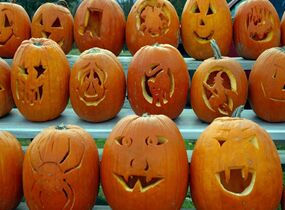万圣节南瓜能吃吗?
|
When people visit their local family-owned pumpkin patch around Halloween, they aren't usually looking for dinner. The majority of the nearly 2 billion pounds of pumpkins cultivated in the US each year are carved up instead of eaten, making the squash a unique part of the agriculture industry. For people who prefer seasonal recipes to decorations, that may raise a few questions: Are the pumpkins sold for jack-o'-lanterns different from pumpkins sold as food? And are Halloween pumpkins any good to eat? The pumpkins available at farms and outside supermarkets during October are what most people know, but that's just one type of pumpkin. Howden pumpkins are the most common decorative pumpkin variety. They've been bred specifically for carving into jack-o'-lanterns, with a symmetrical round shape, deep orange color, and sturdy stem that acts as a handle.
Because they're bred to be decoration first, carving pumpkins don't taste very good. They have walls that are thin enough to poke a cheap knife through and a texture that's unappealing compared to the squashes consumers are used to eating. "Uncut carving pumpkins are safe to eat; however, it's not the best type to use for cooking," Daria McKelvey, a supervisor for the Kemper Center for Home Gardening at the Missouri Botanical Garden, tells Mental Floss. "Carving pumpkins are grown for their large size, not the flavor. Their flesh can be bland and the fibers are very stringy." To get the best-tasting pumpkins possible this autumn, you're better off avoiding the seasonal supermarket displays. Many pumpkin varieties are bred especially for cooking and eating. These include Sugar Pie, Kabocha, and Cinderella pumpkins. You can shop for these varieties by name at local farms or in the produce section of your grocery store. They should be easy to tell apart from the carving pumpkins available for Halloween: Unlike decorative pumpkins, cooking pumpkins are small and dense. This is part of the reason they taste better. McKelvey says. "[Cooking pumpkins] are smaller, sweeter, have a thicker rind (meatier), and have less fibers, making them easier to cook with—but not so good for carving." These pumpkins can be stuffed, blended into soup, or simply roasted. If you do want to get some culinary use out of your carving pumpkins this Halloween, set aside the seeds when scooping out the guts. Roasted with seasonings and olive oil, seeds (or pepitas) from different pumpkin varieties become a tasty and nutritious snack. Another option is to turn the flesh of your Halloween pumpkin into purée. Adding sugar and spices and baking it into a dessert can do a lot to mask the fruit's underwhelming flavor and consistency. Whatever you do, make sure your pumpkin isn't carved up already when you decide to cook with it. There are many ways to recycle your jack-o'-lanterns, but turning them into pie isn't one of them. "If one does plan on cooking with a carving pumpkin, it should be intact," McKelvey says. "Never use one that's been carved into a jack-o'-lantern, otherwise you could be dealing with bacteria, dirt and dust, and other little critters." |









